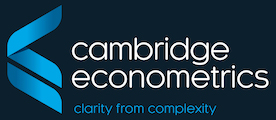The “Filter” menu (top left) can be used to select and visualise features of interest on the map. The user can also zoom in and out of the map and click on specific features to highlight more information.
Map features and “Filter” menu capabilities
Select features
Sectors can be selected from the two sector lists, RTIC sectors and SIC-based sectors. Up to 5 sectors can be overlaid on the map at one time. These can be selected from across the two lists. These selections can be made by looking through the expandable list of sectors, or by searching for a sector.
Some pre-defined Groups of Sectors have also been made available at the top of the Filter menu. These are listed below with group names and the assigned RTICs (or SIC based IDBR sectors, if stated):
- Advanced Materials
- Advanced Manufacturing
- Advanced Materials
- AgriTech
- AgriTech
- Food Tech
- Artificial Intelligence
- Artificial Intelligence
- Clean Tech
- CleanTech
- Energy Generation
- Energy Storage
- Net Zero
- Computer Hardware/Semiconductors
- Computer Hardware
- Digital
- Agency Market
- Artificial Intelligence
- Cyber
- Data Infrastructure
- Digital Creative Industries
- EdTech
- FinTech
- Gaming
- Immersive Technologies
- Media Publishing [SIC Based (IDBR)]
- Software and IT [SIC Based (IDBR)]
- Software as a Service (SaaS)
- Software Development
- Streaming Economy
- Telecommunications
- Life Sciences
- Bioscience (SIC based IDBR)
- Life Sciences
- MedTech
- Omics
- Pharma
- Quantum
- Photonics
- Quantum Economy
- Telecomms
- Telecommunications
The location of universities and catapults, and public R&D laboratories can also be added to your map, along with the research income of universities. These are not shown by default but can be switched “on” and “off” of in the “Public supported R&D facilities” section of the Filter menu. The universities identified are the most research-intensive universities (also called Trac A and Trac B, which refers to the percentage of university income that is research income).
Filter features
Once sector selections have been made, it is also possible to filter the sector clusters based on several cluster-level metrics in the Filters menu, using a slider to increase or decrease the number:
- Number of company sites (company location counts)
- Percentage of UK companies in the sector found in each cluster (based on company location counts)
The user can also filter based on cluster type using the options listed across the top of the map.
By default, all clusters relating to the sector(s) selected will be displayed unless filters are applied.
Base map options
The user can change the base map in the map menu to the top right of the map.
The user can also switch on ITL1 or ITL2 region boundaries (created Jan 2018, last updated Sept 2022) with region labels, sourced from the ONS. These are not interactive, but can be used as a reference or guide for users interested in administrative regions (to which most spatial data for R&D has been constrained in the past).
Accessing the data held within the tool
This tool has produced cluster-level company metrics relating to company financials, employees, investment and growth for the companies which have a known location within the geographical boundary of the cluster, where the data is available.
Once sector selection has been made, this information can be accessed by clicking on any cluster, which will generate a pop-up containing the metrics organised across a series of tabs.
Note: It is only possible to click the cluster in a position where it is the top layer. Other sectors may need to be de-selected to allow access to the cluster of interest.
Similarly, clicking on the universities or catapult locations will reveal the name of the institution and research investment information, where available.
Pop-up metrics
Definitions and caveats
x% of sector found in this cluster:
The Company location count of a given cluster (as described below), as a percentage of the total company location counts in the sector.
Cluster type:
Please see the definitions on the about page.
“Company” tab
Company location count:
A total count of the distinct locations of companies in the cluster which are located within the geographic cluster boundary. This includes both registered and operating locations.
Distinct companies:
A total count of distinct companies in the cluster which are located within the geographic cluster boundary.
Estimated Turnover – RTIC sectors:
A total of the current turnover allocated to the locations of companies (in the given sector) which are located within the cluster’s geographic boundary. This is an estimate for 2022, since not all companies report turnover, and there is a lag from the reporting date.
Estimated Employee Count – RTIC sectors:
A total of the current employees allocated to the locations of companies (in the given sector) which are located within the cluster’s geographic boundary. This is an estimate for 2022, since not all companies report employee counts, and there is a lag from the reporting date.
Additional caveats:
All company locations are allocated an even share of the company’s total estimated turnover/employee count, since a more nuanced weighting is not possible. The metrics do not account for the turnover/employees in a given company/company location which is generated through operations explicitly relate to another sector (for instance, if the company operates in multiple sectors). Instead, all estimated turnover/employees are allocated to the sector within which the company has been classified.
Estimated Turnover – SIC based sectors:
This is the total turnover reported by the companies within the cluster, shared proportionally to the number of employees in each local office, based on the 2018 Inter-Departmental Business Register (IDBR) dataset. More information can be found in the Appendix of the accompanying project report.
Employee Count – SIC based sectors:
This is the total number of employees reported by the local offices of companies within the cluster, based on the 2018 Inter-Departmental Business Register (IDBR) dataset.
“Investment” tab
Investment (IUK):
This is the total approved research investment from Innovate UK in the past 7 years (Sep’ 2016 – Jan’ 2023) for the companies in the cluster which are in receipt of IUK investment.
Investment (Rest of UKRI):
This is the total approved research investment from UK Research and Innovation (excluding Innovate UK investment) in the past 7 years (Sep’ 2016 – Jan’ 2023) for the companies in the cluster which are in receipt of UKRI investment.
VC Investment:
The total investment that has been received in the past 4 years (Aug’ 2019 – Aug’ 2023) by companies with a registered address in the cluster. The total investment for each company is allocated to the registered address, and thus the cluster containing the registered address, in absence of information on how the investment was deployed. This includes investment from many different rounds, ranging from, for example, Seed to Established.
This data is sourced from Dealroom.
Top Known Investors:
This is the names of the known investors providing the greatest total VC investment to companies with registered addresses in the cluster. Investors are again allocated to the cluster containing the registered address of the company receiving the investment, in absence of information on how the investment was deployed. Where available, the top 3 known investors are listed, or the top joint 3 investors, where multiple investors have invested the same amount. Where fewer than 3 investors are listed, this does not mean that they are the only investors and/or have provided all of the investment listed, these are just the only investors with a name reported. Again, this data is sourced from Dealroom.
Additional investment caveats:
If the investment allocation of a project to each collaborator is not available, the total investment is shared equally between its collaborators. The investment each organisation received is summed together, identified by its Company Reference Number (CRN) or the IUK Applicant ID.
When appending investment per organisation to the IDBR and RTIC datasets, we split the investment equally by the number of offices of that organisation. For example, if enterprise X has 5 offices and received £10,000 in investment, each office is assumed to have received £2,000 in investment. This avoids double counting investment received especially if more than one office appears in the same cluster.
Some investment assigned to academic institutions are not identified because they often have no CRN. This undercounted investment received by IDBR and RTIC clusters.
“Growth Stage” tab
This breakdown of the companies with locations within the cluster is estimated by The Data City considering incorporation date, estimated employee info, estimated turnover, and growth potential and investment data, where the data is available. Specific weightings and boundaries are applied (typically a minimum or maximum) to allocate a final growth stage classification to each company (classifications: Established, Large scale-up, Scale-up, Seed, SME and Start-up).
Note: This is an estimate since it is based on the estimated employees.
Additional data information:
Reported business counts, turnover and employee data for the companies in the RTIC clusters are based upon the data submitted at Companies House. This data is limited in that only approximately 100,000 of the 5.3m registered companies submit their full financials to Companies House. Additionally, only approximately 75% of these companies submit employee data. Estimates are made based upon this limited data source. RTIC company location data is restricted to (1) registered addresses; and (2) operating addresses, which The Data City have identified as listed on the company’s website.

